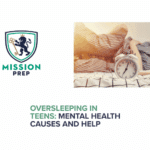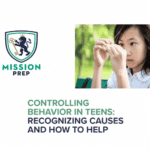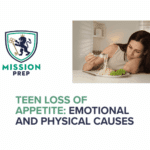Teen Mood Swings: Causes, Symptoms, and How to Help

One moment, your teen may be laughing with you while eating dinner, but the next, they’ve run off in tears, slamming their bedroom door behind them. If you’re familiar with such scenarios, you may often feel confused and wonder what happened. But you’re not alone.
Mood swings are a normal part of adolescence, yet they can still feel perplexing and overwhelming for all involved.
While some ups and downs in mood are normal for teens, rapid emotional changes or extreme highs and lows may signal that something deeper is going on. Understanding the difference between “normal” teen mood swings and a more profound issue may be the key to protecting your child’s mental health.
If you’re concerned about your teen’s moods, talking to a mental health professional is advised. This page can also help you better understand adolescent mood swings by covering:
- What teenage mood swings are
- Causes of mood swings in teens
- When emotional instability is a sign of a mental health condition
- Common mental health conditions in adolescents
- Coping with mood swings: professional help and parental support

Understanding Adolescent Mood Swings
One of the things people most commonly associate with adolescence is mood swings. Oscillating between smiling and rolling eyes, laughing and then lashing out, teen emotions can feel like a rollercoaster. But why are teen mood swings so common?
The teenage years are a time of significant change. Puberty can bring a significant amount of hormonal fluctuations, emotions might feel more intense, and responsibilities and academic expectations may lead to chronic stress. Issues such as these can all combine to trigger emotional instability in teens.
While adolescence is a crucial developmental period in a person’s life, it can also feel challenging due to these changes. With the brain still developing, teenagers may struggle to manage or express intense emotions healthily – often leading to mood swings.
Fortunately, teenage mood swings are typically temporary. However, if mood changes are rapid, severe, and have an impact on a teen’s ability to function, they may be a sign of a deeper problem. For instance, they may signal an underlying mental health condition such as anxiety, depression, or bipolar disorder. If this is the case, learning teen emotional regulation skills may be an important step toward improved well-being.
Before we look at the differences between “typical” teen moodiness and signs of an emotional issue, let’s explore the causes of mood swings in more detail.
Causes of Teen Mood Swings
There are several factors that can play a role in teen mood swings, and understanding these may help you and your teen cope better with them. Some of these factors include:
Hormonal Changes and Brain Development
As mentioned earlier, hormonal changes and mood swings are intrinsically linked. Puberty can trigger a surge of hormones, such as estrogen, progesterone, and testosterone. These hormones can affect the area of the brain (the prefrontal cortex) responsible for mood regulation, decision making, and self-control, which is still developing. The result can be emotional outbursts, increased irritability, and more emotional sensitivity overall.1-3
Stress
There is a clear connection between stress and mood swings in adolescents, and two major sources of stress for teens can be academic and social pressures. Between finishing homework on time, exam anxiety, worries about college prep, and keeping up with extracurriculars, it’s understandable why some teens feel overwhelmed. Additionally, they may be experiencing changes in their friendship groups, peer pressure, or even bullying.4,5 These stressors can have a significant impact on mood.
Sleep Deprivation
The link between sleep and mood has been well-established in adults for years, and you may even be familiar with the cranky feeling that comes after a bad night’s sleep. However, poor quality sleep can particularly affect a teen’s mood. Teens’ internal body clocks shift during puberty, meaning they often can’t fall asleep until much later than desirable. On top of this, adolescents often have to wake up early for school. This pattern can result in sleep deprivation, contributing to mood swings and emotional dysregulation.6
Diet and Lifestyle
Lifestyle can have a significant impact on mood. For example, eating a healthy, varied, balanced diet has been shown to contribute to better mood, as does regularly exercising.7,8 These factors are essential for overall well-being, and especially for teen development. Therefore, if a teen isn’t eating well or is lacking exercise or sleep, they may experience mood swings.
Neurodiversity
Neurodiverse teens, such as those with attention-deficit hyperactivity disorder (ADHD), may experience more frequent or severe mood swings due to the link between neurodevelopmental disorders and emotional and behavioral challenges.9,10
Based on these factors, there is often more to teenage “moodiness” than just hormones. However, parents may wonder when adolescent mood swings cross the line into something more serious, like a mental health condition. The following section explores how to recognize mood disorders in teens.
Recognizing Mood Disorders in Teens
- Emotional or behavioral changes that last longer than two weeks
- Symptoms that cause your teen or family distress
- Losing interest in things they used to enjoy
- Changes that interfere with their ability to function, whether at home, school, or with friends
- Fatigue or having very low energy
- Withdrawing or isolating themselves from friends and family
- Sudden or severe changes in their emotions or personality
- Risky or self-destructive behaviors
- Self-harming or having thoughts of suicide
If your child is having thoughts of suicide, seek immediate help by contacting their doctor, attending your nearest emergency room, or calling 911.
If any of the above symptoms seem familiar, they may be signs that your teen is struggling with a mental illness. You may feel reassured to know that these conditions can be treated very effectively, allowing your teen to fully recover. The next section will cover some of the most common mood disorders in adolescents.
Common Mood Disorders in Teens
Mood swings often share symptoms with mental health conditions. Recognizing the signs of the most common mood disorders teens can develop may help your child receive the support they need.
Three of these common mental health conditions in teens are briefly explained below.
Adolescent Anxiety
Anxiety is a common problem affecting nearly a third of teens.13 Anxiety disorders involve intense, excessive, and persistent worries or fears about everyday situations, accompanied by feelings of intense anxiety and panic. They can interfere with daily activities, feel overwhelming, and make someone feel as though they have no control.
Symptoms of anxiety can vary between teens. However, some of the most common signs include:14
- Fears and worries about daily life
- Feeling irritable or anxious
- Issues concentrating
- Avoiding new situations
- Stomachaches or headaches
- Seeking constant reassurance
- Sleep issues
- A decline in school performance
- Withdrawing from social activities
Teenage Depression
Depression affects roughly 20% of U.S adolescents and is characterized by a persistent feeling of extreme sadness or despair.15,16 It can impact a teen’s ability to think, sleep, eat, and learn, with teen depression symptoms such as:17
- Feeling sad, hopeless, worthless, irritated, overwhelmed, or emotionally “numb”
- Losing interest in activities they once enjoyed
- Low self-esteem
- Withdrawal from family and friends
- Difficulty concentrating
- Fatigue, tiredness, or exhaustion
- School difficulties, such as a drop in grades or regular absences
- Physical complaints, such as aches or pains without a clear cause
- Changes in appetite
Teen Bipolar Disorder
Bipolar disorder is a condition that affects almost three in every hundred teens in the U.S, causing severe mood swings, high energy moods (mania), and overwhelming lows (depression).18 It can be a difficult condition to recognize in teens due to mood swings being a natural part of adolescence; however, bipolar disorder goes beyond typical mood swings. Some of the most common signs of bipolar disorder in teens are:19
- Manic episodes:
- Intense happiness or “silliness” for long periods of time
- Irritability or short-temperedness
- Talking rapidly
- Having problems sleeping, but not feeling tired
- Racing thoughts
- Recklessness or risk-taking behaviors
- Depressive episodes:
- Feeling extremely sad, hopeless, or worthless
- Irritability or anger
- Physical aches and pains
- Sleeping more than usual, but having low energy
- Difficulty concentrating
- Changes in appetite
- Difficulty communicating
- Thoughts of death or suicide
If you recognize symptoms of one of the conditions mentioned above, your child may be experiencing more than “typical” teen mood swings. Mental health challenges in adolescents are common, and effective treatments – such as therapy – can help your teen feel like their normal selves again.
The following sections explore the professional help options available for teens and how parents can support their children at home.
Coping With Teen Mood Swings: Professional Help and Parental Support
Teen mood swings can feel intense, both for teenagers and their parents. However, if emotional fluctuations feel more severe than usual, leaving your child unable to function, or if you notice red flags from earlier, your teen may benefit from professional support.
Therapy for mood disorders offers a safe space for teens to explore their inner emotional world with a therapist. They can develop their self-awareness, learn how to manage their moods more effectively, and heal.
Early intervention for mood disorders or mood swings can help teens find relief from their symptoms and feel more balanced going forward in life.
Parental Support for Teens With Mood Swings
Parents often play an important role in supporting teens with their moods. The things they do and say can have a significant impact on a child, and there are many steps they can take to help their teens through their challenges.
Some suggestions for parents seeking to support their teen are:
- Keep your cool: Teen mood swings can be highly provocative, but raising your voice or responding negatively can be counterproductive. Try talking to your teen in a calm, firm manner.
- Be a role model for healthy coping: Talk to your teen about how you deal with your moods, and show them what you do to cope. For instance, you could share some of your healthy go-to techniques for releasing stress or anger that may also be useful for managing teen irritability.
- Communicate openly: Encourage open and honest communication with your teen. Let them know they can talk to you about anything, that you will take their feelings seriously, and that you won’t judge them. However, respect needs to be kept in open and honest communication, so ensure that boundaries around language or behavior are maintained.
- Encourage healthy habits: Helping your teen to keep a healthy routine can make a big difference to their overall well-being and health. Encourage a lifestyle with sleep routines, regular exercise, and a balanced diet to help them feel better physically and emotionally.
Mood swings are natural during adolescence, but if they are causing your teen distress or problems functioning in their daily activities, they may benefit from extra support. There’s no shame in reaching out – we all need a little help sometimes.

Mission Prep: Providing Support for Teens and Their Families
Being a teenager can be difficult, sometimes leading to emotional ups and downs, which can be challenging for both teens and their parents. If you are concerned that mood swings are negatively affecting your child, professional support and guidance are available.
Mission Prep is here to help. We specialize in assisting teens with healing from mental and emotional challenges, and provide support for their families alongside. With options such as individual therapy, telehealth, family counseling, medication management, intensive outpatient programs, and residential care, we can help your teen in a way that fits their schedule.
Mood swings don’t have to take over your teen’s life or your family dynamic. If you’re ready to find out how we can help your child, contact us today.
References
- Harvard Health. (2011, March 7). The adolescent brain: Beyond raging hormones. https://www.health.harvard.edu/mind-and-mood/the-adolescent-brain-beyond-raging-hormones
- National Institute of Mental Health (NIMH). (2023). The Teen Brain: 7 Things to Know. https://www.nimh.nih.gov/health/publications/the-teen-brain-7-things-to-know
- Hathaway, W. R., & Newton, B. W. (2023, May 29). Neuroanatomy, prefrontal cortex. StatPearls – NCBI Bookshelf. https://www.ncbi.nlm.nih.gov/books/NBK499919/
- Deng, Y., Cherian, J., Khan, N. U. N., Kumari, K., Sial, M. S., Comite, U., Gavurova, B., & Popp, J. (2022). Family and academic stress and their impact on students’ depression level and academic performance. Frontiers in Psychiatry, 13. https://doi.org/10.3389/fpsyt.2022.869337
- News In Health. (2024, June 18). The power of peers. https://newsinhealth.nih.gov/2021/09/power-peers
- Baum, K. T., Desai, A., Field, J., Miller, L. E., Rausch, J., & Beebe, D. W. (2013). Sleep restriction worsens mood and emotion regulation in adolescents. Journal of Child Psychology and Psychiatry, 55(2), 180–190. https://doi.org/10.1111/jcpp.12125
- American Psychological Association. (2024, October 22). How to help children and teens manage their stress. https://www.apa.org/topics/children/stress
- Crichton-Stuart, C. (2025, May 20). What are some foods to ease anxiety? Medical News Today. https://www.medicalnewstoday.com/articles/322652#dark-chocolate
- World Health Organization. (2025, September 1). Mental health of adolescents. https://www.who.int/news-room/fact-sheets/detail/adolescent-mental-health
- Stoewen D. L. (2022). Nature, nurture, and mental health Part 1: The influence of genetics, psychology, and biology. The Canadian veterinary journal, 63(4), 427–430. https://pmc.ncbi.nlm.nih.gov/articles/PMC8922370/
- Sappenfield, O., Alberto, C., Minnaert, J., Donney, J., Lebrun-Harris, L., & Ghandour, R. (2024, October 1). Adolescent Mental and Behavioral Health, 2023. National Survey of Children’s Health Data Briefs – NCBI Bookshelf. https://www.ncbi.nlm.nih.gov/books/NBK608531/
- National Institute of Mental Health (NIMH). (2024). Children and mental health: Is this just a stage? https://www.nimh.nih.gov/health/publications/children-and-mental-health
- National Institute of Mental Health. (n.d.). Any anxiety disorder. Retrieved October 8, 2025, from https://www.nimh.nih.gov/health/statistics/any-anxiety-disorder
- Miller, C. (2025, August 27). How anxiety affects teenagers. Child Mind Institute. https://childmind.org/article/signs-of-anxiety-in-teenagers/
- National Institute of Mental Health (NIMH). (2023). Major Depression. https://www.nimh.nih.gov/health/statistics/major-depression
- American Psychological Association. (n.d.). Depression. In APA Dictionary of Psychology. Retrieved October 11, 2025, from https://dictionary.apa.org/depression
- Mayo Clinic. (2022, August 12). Teen depression: Symptoms and causes. https://www.mayoclinic.org/diseases-conditions/teen-depression/symptoms-causes/syc-20350985
- National Institute of Mental Health. (n.d.). Bipolar disorder. Retrieved October 8, 2025, from https://www.nimh.nih.gov/health/statistics/bipolar-disorder
- National Institute of Mental Health (NIMH). (2023). Bipolar disorder in children and teens. https://www.nimh.nih.gov/health/publications/bipolar-disorder-in-children-and-teens



















